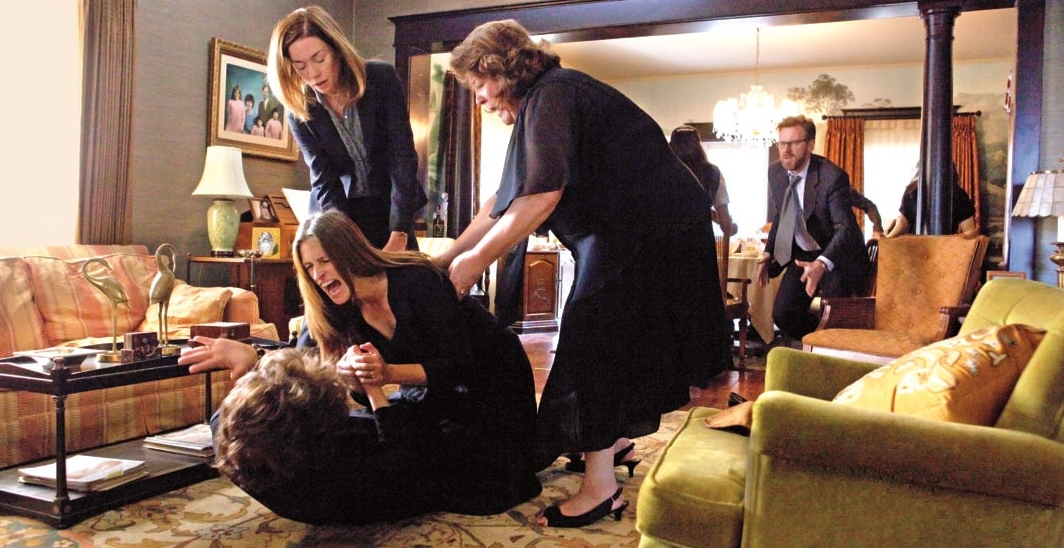Happy Thanksgiving! In these days of family forcefully gathering around for a meal, Jorge takes a look into “August: Osage County” to remind you that your relatives perhaps aren’t so bad after all.

Not unlike Thanksgiving itself, Tracy Lett’s August: Osage County is about a broken family that is bound to be around each other as past secrets, tensions and grievances slowly rise up to the surface.
The emotional climax of both the 2008 Tony-winning play and its subsequent 2013 Oscar-nominated adaptation is an almost 20-minute dinner sequence after the funeral that brought them all together. Matriarch Violet Weston (Meryl Streep) asserts her toxic matriarchal power over her family. And slowly but surely, tensions escalate to the point of explosion...
Let’s see how the script of the movie handles the tension of this scene, making sure it slowly bubbles and intensifies throughout almost twenty pages; as long as how being present on that dinner must have felt like.
August: Osage County
Written by: Tracy Letts, based on his own play
[You can read the full script here. I will be talking about these pages and this scene.]
This infamously uncomfortable dinner (that ends with a full physical confrontation between Violet and her daughter Barbara, played by Julia Roberts), is perhaps the most representative sequence from the film, and from its original source material. But it is also the least cinematic.
It's where the stage origins of the movie are the most evident. It includes some of the most biting lines of dialogue and mini-monologues (Violet’s “Whadda you do?” speech is pure venom), and it’s where the actors get to do some of the most overt and, well, theatrical acting, in particular Violet and Barbara. But it is also all set around a table, one of the trickiest places to creatively shoot around. Every character of the movie is present, and it is basically a 20-minute long conversation, with very little action and all of the dialogue.
Tracy Letts, who wrote the original play and adapted it for the screen, is aware of this. He decides to pull focus into the things that he knows will carry the material: the sharp dialogue and the performances of an all-star cast.

Structurally, this scene is a tug of war, a constant pull-and-push between Violet and her family, Whenever she is about to go too far, someone else comes in and pulls back to release the tension; a tension that, we very well know, can’t be contained for long. Until it doesn’t, and Barbara tackles her mother to take her bottle of pills away. This constant holding and release of stress is what's able to carry audience engagement from start to finish; the omnipresent threat of things exploding always looming over the family.
And just as he does on stage, Letts lets the actors and the words they throw at each other do most of the work. Visually, the pages of the script read as mostly dialogue, with very little action lines placed in between. The scene heading does not change for over 19 pages, which is something incredibly rare in screenplays. He also masterfully uses the dual dialogue feature to convey the chaos of people talking one another, something essential for the mood of the film.

***

Cinematically, director John Wells doesn’t do anything formally radical to convey the tension of the evening. He slips in some carefully picked reaction shots of the family members, and gives Meryl and Julia their respective moments to shine. But he mostly places the camera as an observant, letting the actors have their way with the screenplay.
This scene had all the elements to become a cinematic nightmare: a one-location dialogue-fest with over a dozen actors present. However, instead of trimming it or making it more visually exciting, the script trusts in the actors and the dialogue to carry momentum The end-result was a scene that landed an Oscar nomination for both its leads.
So now that you've spent a single meal with the Westons, go and enjoy a loving holiday with your loved ones. Or flush their pills down the toilet. Hey, it happens in every family. Happy Thanksgiving!